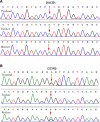A Neonatal Case With Perinatal Lethal Gaucher Disease Associated With Missense G234E and H413P Heterozygous Mutations
- PMID: 31192173
- PMCID: PMC6538945
- DOI: 10.3389/fped.2019.00201
A Neonatal Case With Perinatal Lethal Gaucher Disease Associated With Missense G234E and H413P Heterozygous Mutations
Abstract
Perinatal lethal Gaucher disease (PLGD), a particular and serious form of type 2 Gaucher disease (GD), often causes lethality in utero or death within hours after birth. The typical clinical manifestations include non-immune hydrops fetalis (NIHF), premature birth, fetal growth restriction, fetal intrauterine death, or neonatal distress and rapid death after birth. Here, we present a premature neonate with GD whose main clinical manifestations included intrauterine growth retardation, anasarca, facial dysmorphia, ichthyosis, respiratory distress, hepatosplenomegaly, joint contractures, myoclonus, refractory thrombocytopenia, anemia, elevated levels of liver enzymes, bile acid and direct bilirubin, cholestasis, pulmonary hypoplasia, intracranial hemorrhage, and abnormal electroencephalogram. The activity of β- glucocerebrosidase was 0 in the peripheral white blood cells of the neonate. The sequencing analysis identified the presence of missense G234E and H413P heterozygous mutations in glucerebrosidase (GBA) exon 7 and 10, with the latter first observed to be associated with PLGD. This infant died at 73 days of age.
Keywords: convulsions; hepatosplenomegaly; ichthyosis; premature neonate; thrombocytopenia.
Figures




Similar articles
-
Gaucher disease with prenatal onset and perinatal death due to compound heterozygosity for the missense R131C and null Rec Nci I GBA mutations.Pediatr Dev Pathol. 2011 May-Jun;14(3):240-3. doi: 10.2350/09-11-0744-CR.1. Epub 2010 Oct 14. Pediatr Dev Pathol. 2011. PMID: 20946052
-
A newborn case with perinatal-lethal Gaucher disease due to R463H homozygosity complicated by C677T homozygosity in the MTHFR gene.J Pediatr Endocrinol Metab. 2011;24(5-6):381-3. doi: 10.1515/jpem.2011.001. J Pediatr Endocrinol Metab. 2011. PMID: 21823541
-
Perinatal lethal Gaucher disease due to compound heterozygosity of the splicing mutations in GBA gene.Taiwan J Obstet Gynecol. 2023 Jan;62(1):175-178. doi: 10.1016/j.tjog.2022.07.012. Taiwan J Obstet Gynecol. 2023. PMID: 36720536
-
Perinatal lethal Gaucher disease: A case report and review of literature.Brain Dev. 2023 Feb;45(2):134-139. doi: 10.1016/j.braindev.2022.09.006. Epub 2022 Oct 8. Brain Dev. 2023. PMID: 36220738 Review.
-
Perinatal lethal Gaucher disease: a distinct phenotype along the neuronopathic continuum.Fetal Pediatr Pathol. 2005 Jul-Oct;24(4-5):205-22. doi: 10.1080/15227950500405296. Fetal Pediatr Pathol. 2005. PMID: 16396828 Review.
Cited by
-
Parkinson's Disease Associated with GBA Gene Mutations: Molecular Aspects and Potential Treatment Approaches.Acta Naturae. 2021 Apr-Jun;13(2):70-78. doi: 10.32607/actanaturae.11031. Acta Naturae. 2021. PMID: 34377557 Free PMC article.
-
Do Not Miss the (Genetic) Diagnosis of Gaucher Syndrome: A Narrative Review on Diagnostic Clues and Management in Severe Prenatal and Perinatal-Lethal Sporadic Cases.J Clin Med. 2021 Oct 23;10(21):4890. doi: 10.3390/jcm10214890. J Clin Med. 2021. PMID: 34768410 Free PMC article. Review.
References
Publication types
LinkOut - more resources
Full Text Sources

